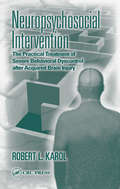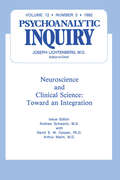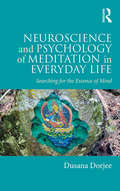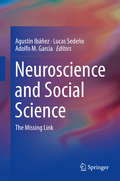- Table View
- List View
The Neuropsychology of Women (Issues of Diversity in Clinical Neuropsychology)
by Elaine Fletcher-JanzenThe “Diversity in Clinical Neuropsychology” series is designed to highlight cultural and moderator variables involved in the study of brain-behavior relationships. Historically, the study of psychology and neuropsychology has focused on the male brain being the standard to which all or most variables are considered. The study of sex differences is perhaps the most provoking and far-reaching aspect of diversity because frequently women have unique assessment and treatment needs. For example, frontal lobe functioning tends to be more contextual for women than for men. These brain functions have behavioral counterparts that directly relate to how interventions may be tailor made to suit the female rather than male patient. The goal in neuropsychology is always to improve diagnosis and treatment outcomes, and a cohesive summary of the neuropsychology of the female brain would raise awareness and cultural competency of clinicians in neuropsychology. Authors will focus on sex differences in the neuropsychological, cognitive, and development literature; ethnic and socioeconomic variables affecting diagnosis and treatment of women; and social/emotional and behavioral manifestations of neuropsychological sex differences.
The Neuropsychology Toolkit: Guidelines, Formats, and Language
by Richard L. WanlassThis book provides information, guidelines, and materials to help future neuropsychology supervisees identify, understand, and avoid some of these problems and pitfalls. Also included are a neuropsychological questionnaire, short- and long-report formats, and sample statements that can be used to help with wording sections of the report that are particularly challenging to write.
The Neuropsychopathology of Schizophrenia: Molecules, Brain Systems, Motivation, and Cognition (Nebraska Symposium on Motivation #63)
by Ming Li William D. SpauldingOne of the first major theoretical reviews of schizophrenia since the publication of the 5th edition of the APA’s Diagnostic and Statistical Manual, the DSM-5, this volume is a landmark in the history of schizophrenia research. It assembles recent groundbreaking developments in research on schizophrenia and reaffirms its central place in the mental health research agenda. Significantly, this volume reflects the paradigmatic shift in schizophrenia research applied in parallel to new approaches in psychiatric diagnosis. New models and findings from across disciplines in recent years reflect a new and greater understanding of the workings of the brain, which, in turn, helps develop our knowledge of the neuro and psychological processes in schizophrenia. Consequently, this volume illustrates a historical convergence of psychology, psychopathology and the neurosciences in schizophrenia.World-renowned leaders of the schizophrenia research community in fields such as neuroscience, psychiatry, neuropsychology, and clinical psychology offer clear suggestions for further advances in psychological and medical interventions, assessment, prevention strategies, and research. And in keeping with other titles in the Nebraska Symposium on Motivation series, these papers are noteworthy for their depth of detail, scientific rigor, and clinical relevance.Included among the topics: Cognitive organization as a dimension of individual differences and psychopathology. Neurodevelopmental genomic strategies in the study of the psychosis spectrum. Multimodal brain and behavior indices of psychosis risk. The NIMH Research Domain Criteria Project: new approaches to classifying psychotic spectrum disorders. The Neuropsychopathology of Schizophrenia is one of the most forward-thinking and engaging treatments of the field in recent years, and is an indispensable text for all researchers, academics, and clinicians who treat or study mental illness, especially psychiatrists, psychologists, mental health practitioners, and neuroscientists specializing in schizophrenia.
Neuropsychopharmacology: Proceedings of the XVIth C.I.N.P. Congress, Munich, August, 15-19, 1988
by W. E. Jr. Bunney Hanns Hippius Gregor Laakmann Max SchmaußNeuropsychopharmacology (Journal Of Neural Transmission. Supplementa Ser. #64)
by W. W. Fleischhacker D. J. BrooksNeuropsychopharmacology of the Trace Amines: Experimental and Clinical Aspects (Experimental and Clinical Neuroscience)
by Alan A. Boulton Peter R. Bieck L. Maitre P. RiedererA probable neurobiological role for the trace amines began to emerge as soon as techniques sufficiently sophisticated to detect them were developed. Techniques for quantitative analyses included radioenzymatic procedures and, more recently, HPlC-EC and auto mated GC-MS. The methods are applied after separation of the sub stances to be analyzed and after their purification by physicochemical procedures that are becoming more and more efficient. The identification and quantitative analysis of minute amounts of trace amines in biological fluids or tissues is in itself a remarkable technological achievement. The enormous task that several teams of research workers have set themselves is to investigate the origin of the trace amines, to understand their metabolism, and to discover whether or not they possess an important biological role. The 2nd Trace Amines Symposium at Weitenburg Castle near Tubingen from the 15th to the 19th May 1985 was held to gain a somewhat clearer insight into the present state of knowledge. Since the first meeting in 1983 our knowledge has increased and interest is deepening. Hence the idea proposed at that first meeting, of organizing similar gather ings at regular intervals, has come to fruition. Covered in the Neuropsychopharmacology section of this book are studiesof the effects of certain trace amines on different forms of be havior, on neurotransmission mediated by . the classical neuro transmitters, on their biosynthesis or on catabolism, on their possible occurrence as a result of alternative metabolic pathways for the amino acids, and in some instances their neuroanatomical distributions.
Neuropsychosocial Intervention: The Practical Treatment of Severe Behavioral Dyscontrol After Acquired Brain Injury
by Robert L. KarolNeuropsychosocial intervention is an innovative and clinically proven treatment approach to severe behavioral problems that can affect persons with acquired brain injury. This book outlines the nature and significance of behavioral dyscontrol, explains aggression, and details the neuropsychosocial treatment approach and the principles on which it i
Neuropsychosocial Intervention: The Practical Treatment of Severe Behavioral Dyscontrol After Acquired Brain Injury
by Robert L. KarolNeuropsychosocial intervention is an innovative and clinically proven treatment approach to severe behavioral problems that can affect persons with acquired brain injury. This book outlines the nature and significance of behavioral dyscontrol, explains aggression, and details the neuropsychosocial treatment approach and the principles on which it i
Neuropsychotherapy: How the Neurosciences Inform Effective Psychotherapy (Counseling and Psychotherapy)
by Klaus GraweNeuropsychotherapy is intended to inspire further development and continual empirical updating of consistency theory. It is essential for psychotherapists, psychotherapy researchers, clinical psychologists, psychiatrists, neuroscientists, and mental-health professionals. Profoundly important and innovative, this volume provides necessary know-how for professionals as it connects the findings of modern neuroscience to the insights of psychotherapy. Throughout the book, a new picture unfolds of the empirical grounds of effective psychotherapeutic work. Author Klaus Grawe articulates a comprehensive model of psychological functioning-consistency theory-and bridges the gap between the neurosciences and the understanding of psychological disorders and their treatment. Neuropsychotherapy illustrates that psychotherapy can be even more effective when it is grounded in a neuroscientific approach. Cutting across disciplines that are characteristically disparate, the book identifies the neural foundations of various disorders, suggests specific psychotherapeutic conclusions, and makes neuroscientific knowledge more accessible to psychotherapists. The book's discussion of consistency theory reveals the model is firmly connected to other psychological theoretical approaches, from control theory to cognitive-behavioral models to basic need theories.
Neuropsychotherapy: How the Neurosciences Inform Effective Psychotherapy (Counseling and Psychotherapy)
by Klaus GraweNeuropsychotherapy is intended to inspire further development and continual empirical updating of consistency theory. It is essential for psychotherapists, psychotherapy researchers, clinical psychologists, psychiatrists, neuroscientists, and mental-health professionals. Profoundly important and innovative, this volume provides necessary know-how for professionals as it connects the findings of modern neuroscience to the insights of psychotherapy. Throughout the book, a new picture unfolds of the empirical grounds of effective psychotherapeutic work. Author Klaus Grawe articulates a comprehensive model of psychological functioning-consistency theory-and bridges the gap between the neurosciences and the understanding of psychological disorders and their treatment. Neuropsychotherapy illustrates that psychotherapy can be even more effective when it is grounded in a neuroscientific approach. Cutting across disciplines that are characteristically disparate, the book identifies the neural foundations of various disorders, suggests specific psychotherapeutic conclusions, and makes neuroscientific knowledge more accessible to psychotherapists. The book's discussion of consistency theory reveals the model is firmly connected to other psychological theoretical approaches, from control theory to cognitive-behavioral models to basic need theories.
Neuropsychotherapy and Community Integration: Brain Illness, Emotions, and Behavior (Critical Issues in Neuropsychology)
by Tedd JuddThis volume provides comprehensive coverage of interventions for emotional and behavioral problems following all types of brain illnesses and injuries in adults. It is a unique guide to different settings, families, cultures, illnesses and levels of severity. It takes neuropsychotherapy outside the clinic to the real life situations and dilemmas of people with brain illnesses. It contains case studies, summaries of major techniques and principles in frequent tables which can serve as clinical guides.
NeuroRehabilitation: Ein Praxisbuch für interdisziplinäre Teams
by Peter Frommelt Hubert LössleinIm Praxisbuch wird das gesamte Arbeitsfeld der Rehabilitation nach neurologischen Verletzungen und Erkrankungen umfassend und auf dem neuesten wissenschaftlichen Stand beschieben. Die Autoren stellen evidenzbasierte Konzepte vor, die sich direkt in der therapeutischen Praxis umsetzen lassen. Die Neuauflage wurde übersichtlicher gestaltet und aktualisiert, der Akzent stärker bei teilstationärer und ambulanter Rehabilitation gesetzt. Der Band bietet beides: eine umfassende Einführung für Einsteiger sowie neue Anregungen für erfahrene Therapeuten.
NeuroRehabilitation: Ein Praxisbuch für interdisziplinäre Teams
by Holger Grötzbach Peter Frommelt Angelika Thöne-OttoDas Praxisbuch der Neurorehabilitation…… komplett aktualisiert und überarbeitet: Das große Praxisbuch bietet Grundlagen- und Praxiswissen, detailliert, kritisch, verständlich und an den Bedürfnissen der Patienten orientiert – ein rundum alltagstaugliches Arbeitsbuch für Teams, ein Lehrbuch für die Aus- und Weiterbildung. Mit neuen Kapiteln u.a. zu Telerehabilitation und der Umsetzung spezieller Therapieformen wie Virtual Reality, musikgestützte Therapie, Natur und Tiere.Umfassend: Mit ausführlicher Darstellung der Grundlagen und der Tätigkeitsfelder, beginnend von der Behandlung auf der Stroke Unit bis hin zur Rückkehr in Familie und Beruf.Interdisziplinär: Die gemeinsame Ausbildungs – und Arbeitsgrundlage für alle Berufsgruppen, die in interdisziplinären Teams zusammenarbeiten: Ärzte, Pflegekräfte, Physiotherapeuten, Ergotherapeuten, Logopäden, Neuropsychologen, Sozialpädagogen, Musiktherapeuten u.a.Aktuell: Wissenschaftlich, evidenzbasiert, durchgängig mit bio-psycho-sozialer Orientierung und von den Prinzipien der ICF (Internationale Klassifikation der Funktionsfähigkeit, Behinderung und Gesundheit) geleitet.Kompetent: Fundiertes Fachwissen aus langjähriger Erfahrung, vermittelt von über 50 renommierten internationalen Autoren (aus Deutschland, Schweiz, Großbritannien, Finnland, USA).Informativ: Auch mit Reflexionen über Themen wie „Kontextsensitive Neurorehabilitation“ „Teamarbeit und Zielsetzung“, „Sexualität“, „ Identität und Biografie“, „Holistische neuropsychologische Rehabilitation“.Leserfreundlich: Leicht zugänglich mitEinheitlicher Aufbau der Kapiteloptischer Textstrukturierung: mit Trailers, Praxistipps, Übersichtsboxen, Exkursen („Näher betrachtet“) und mehr…
Neuroscience: Psychoanalytic Inquiry, 12.3
by Andrew SchwartzFirst published in 1992. Routledge is an imprint of Taylor & Francis, an informa company.
Neuroscience: Psychoanalytic Inquiry, 12.3
by Andrew SchwartzFirst published in 1992. Routledge is an imprint of Taylor & Francis, an informa company.
Neuroscience and Art: The Neurocultural Landscape (Neurocultural Health and Wellbeing)
by Amy IoneThis book is focused on how understanding ourselves as humans is incomplete without considering both biological and cultural aspects. Using the neurocultural perspective, the book explores how everything in the world is filtered back and forth through the brain and culture. The thrust of the book, therefore, is to explore the power of art in creating a bridge between cultural and neuroscientific lines of inquiry. Looking at both clinical and non-clinical populations, the text examines historical foundations, distinguishes congenital/developmental conditions from those that are acquired, and emphasizes how the brain constructs our sensory experiences. Several distinctive features separate this research from other publications. First, the book opens with a review of how the historical literature is still etched into the ideas we employ to explain elements across the interdisciplinary fields of art, aesthetics, our sensory experience, psychology, cognition, and well-being. Second, the research adopts a humanistic rather than a philosophical or social science perspective in demonstrating the value of coupling anatomy and physiology with the natural and social environment. In this, artists from all genres are incorporated. Among them are Iris Murdoch, Ludwig van Beethoven, Leonardo da Vinci, Cristoforo de Predis, Rembrandt, Federico Fellini, Chuck Close, and David Hockney. Case studies demonstrate how neuroscientific research meshes with art, individual, and cultural variables in ways that range from health and well-being to physiological decline and biological traumas. These include a case study that examines how Oliver Sacks combined biology and biography in his writings. It also explores art projects in several genres inspired by his studies. Another case study is on the role of film as a useful clinical tool. Here the book also demonstrates that cinematic devices used by filmmakers intersect with perceptual and cognitive neuroscience. A defining feature of the analysis is the integration of research on brain injuries with humanistic responses in film, literature, and the visual arts. This section outlines the lack of consensus regarding the causes and treatment of “shell shock” in World War I before introducing how research and art now work with PTSD/TBI. Finally, the book examines therapeutic cases of professional and non-professional artists, concluding with a discussion of synesthesia and the senses.
Neuroscience and Connectionist Theory (Developments in Connectionist Theory Series)
by Mark A. Gluck David E. RumelhartWritten for cognitive scientists, psychologists, computer scientists, engineers, and neuroscientists, this book provides an accessible overview of how computational network models are being used to model neurobiological phenomena. Each chapter presents a representative example of how biological data and network models interact with the authors' research. The biological phenomena cover network- or circuit-level phenomena in humans and other higher-order vertebrates.
Neuroscience and Connectionist Theory (Developments in Connectionist Theory Series)
by Mark A. Gluck David E. RumelhartWritten for cognitive scientists, psychologists, computer scientists, engineers, and neuroscientists, this book provides an accessible overview of how computational network models are being used to model neurobiological phenomena. Each chapter presents a representative example of how biological data and network models interact with the authors' research. The biological phenomena cover network- or circuit-level phenomena in humans and other higher-order vertebrates.
Neuroscience and Critique: Exploring the Limits of the Neurological Turn
by Ed Pluth Jan De VosRecent years have seen a rapid growth in neuroscientific research, and an expansion beyond basic research to incorporate elements of the arts, humanities and social sciences. It has been suggested that the neurosciences will bring about major transformations in the understanding of ourselves, our culture and our society. In academia one finds debates within psychology, philosophy and literature about the implications of developments within the neurosciences, and the emerging fields of educational neuroscience, neuro-economics, and neuro-aesthetics also bear witness to a ‘neurological turn’ which is currently taking place. Neuroscience and Critique is a ground-breaking edited collection which reflects on the impact of neuroscience in contemporary social science and the humanities. It is the first book to consider possibilities for a critique of the theories, practices, and implications of contemporary neuroscience. Bringing together leading scholars from several disciplines, the contributors draw upon a range of perspectives, including cognitive neuroscience, critical philosophy, psychoanalysis, and feminism, and also critically examine several key ideas in contemporary neuroscience, including: The idea of "neural personhood" Theories of emotion in affective neuroscience Empathy, intersubjectivity and the notion of "embodied simulation" The concept of an "emo-rational" actor within neuro-economics. The volume will stimulate further debate in the emerging field of interdisciplinary studies in neuroscience, and will appeal to researchers and advanced students in a range of disciplines including critical psychology, philosophy, and critical studies.
Neuroscience and Critique: Exploring the Limits of the Neurological Turn
by Ed Pluth Jan De VosRecent years have seen a rapid growth in neuroscientific research, and an expansion beyond basic research to incorporate elements of the arts, humanities and social sciences. It has been suggested that the neurosciences will bring about major transformations in the understanding of ourselves, our culture and our society. In academia one finds debates within psychology, philosophy and literature about the implications of developments within the neurosciences, and the emerging fields of educational neuroscience, neuro-economics, and neuro-aesthetics also bear witness to a ‘neurological turn’ which is currently taking place. Neuroscience and Critique is a ground-breaking edited collection which reflects on the impact of neuroscience in contemporary social science and the humanities. It is the first book to consider possibilities for a critique of the theories, practices, and implications of contemporary neuroscience. Bringing together leading scholars from several disciplines, the contributors draw upon a range of perspectives, including cognitive neuroscience, critical philosophy, psychoanalysis, and feminism, and also critically examine several key ideas in contemporary neuroscience, including: The idea of "neural personhood" Theories of emotion in affective neuroscience Empathy, intersubjectivity and the notion of "embodied simulation" The concept of an "emo-rational" actor within neuro-economics. The volume will stimulate further debate in the emerging field of interdisciplinary studies in neuroscience, and will appeal to researchers and advanced students in a range of disciplines including critical psychology, philosophy, and critical studies.
Neuroscience and Education: A Philosophical Appraisal (Routledge International Studies in the Philosophy of Education)
by Clarence W. JoldersmaThis volume makes a philosophical contribution to the application of neuroscience in education. It frames neuroscience research in novel ways around educational conceptualizing and practices, while also taking a critical look at conceptual problems in neuroeducation and at the economic reasons driving the mind-brain education movement. It offers alternative approaches for situating neuroscience in educational research and practice, including non-reductionist models drawing from Dewey and phenomenological philosophers such as Martin Heidegger and Merleau-Ponty. The volume gathers together an international bevy of leading philosophers of education who are in a unique position to contribute conceptually rich and theoretically framed insight on these new developments. The essays form an emerging dialogue to be used within philosophy of education as well as neuroeducation, educational psychology, teacher education and curriculum studies.
Neuroscience and Education: A Philosophical Appraisal (Routledge International Studies in the Philosophy of Education)
by Nel Noddings Clarence W. JoldersmaThis volume makes a philosophical contribution to the application of neuroscience in education. It frames neuroscience research in novel ways around educational conceptualizing and practices, while also taking a critical look at conceptual problems in neuroeducation and at the economic reasons driving the mind-brain education movement. It offers alternative approaches for situating neuroscience in educational research and practice, including non-reductionist models drawing from Dewey and phenomenological philosophers such as Martin Heidegger and Merleau-Ponty. The volume gathers together an international bevy of leading philosophers of education who are in a unique position to contribute conceptually rich and theoretically framed insight on these new developments. The essays form an emerging dialogue to be used within philosophy of education as well as neuroeducation, educational psychology, teacher education and curriculum studies.
Neuroscience and Psychology of Meditation in Everyday Life: Searching for the Essence of Mind
by Dusana DorjeeNeuroscience and Psychology of Meditation in Everyday Life addresses essential and timely questions about the research and practice of meditation as a path to realization of human potential for health and well-being. Balancing practical content and scientific theory, the book discusses long-term effects of six meditation practices: mindfulness, compassion, visualization-based meditation techniques, dream yoga, insight-based meditation and abiding in the existential ground of experience. Each chapter provides advice on how to embed these techniques into everyday activities, together with considerations about underlying changes in the mind and brain based on latest research evidence. This book is essential reading for professionals applying meditation-based techniques in their work and researchers in the emerging field of contemplative science. The book will also be of value to practitioners of meditation seeking to further their practice and understand associated changes in the mind and brain.
Neuroscience and Psychology of Meditation in Everyday Life: Searching for the Essence of Mind
by Dusana DorjeeNeuroscience and Psychology of Meditation in Everyday Life addresses essential and timely questions about the research and practice of meditation as a path to realization of human potential for health and well-being. Balancing practical content and scientific theory, the book discusses long-term effects of six meditation practices: mindfulness, compassion, visualization-based meditation techniques, dream yoga, insight-based meditation and abiding in the existential ground of experience. Each chapter provides advice on how to embed these techniques into everyday activities, together with considerations about underlying changes in the mind and brain based on latest research evidence. This book is essential reading for professionals applying meditation-based techniques in their work and researchers in the emerging field of contemplative science. The book will also be of value to practitioners of meditation seeking to further their practice and understand associated changes in the mind and brain.
Neuroscience and Social Science: The Missing Link
by Agustín Ibáñez Lucas Sedeño Adolfo M. GarcíaThis book seeks to build bridges between neuroscience and social science empirical researchers and theorists working around the world, integrating perspectives from both fields, separating real from spurious divides between them and delineating new challenges for future investigation. Since its inception in the early 2000s, multilevel social neuroscience has dramatically reshaped our understanding of the affective and cultural dimensions of neurocognition. Thanks to its explanatory pluralism, this field has moved beyond long standing dichotomies and reductionisms, offering a neurobiological perspective on topics classically monopolized by non-scientific traditions, such as consciousness, subjectivity, and intersubjectivity. Moreover, it has forged new paths for dialogue with disciplines which directly address societal dynamics, such as economics, law, education, public policy making and sociology. At the same time, beyond internal changes in the field of neuroscience, new problems emerge in the dialogue with other disciplines.Neuroscience and Social Science – The Missing Link puts together contributions by experts interested in the convergences, divergences, and controversies across these fields. The volume presents empirical studies on the interplay between relevant levels of inquiry (neural, psychological, social), chapters rooted in specific scholarly traditions (neuroscience, sociology, philosophy of science, public policy making), as well as proposals of new theoretical foundations to enhance the rapprochement in question.By putting neuroscientists and social scientists face to face, the book promotes new reflections on this much needed marriage while opening opportunities for social neuroscience to plunge from the laboratory into the core of social life. This transdisciplinary approach makes Neuroscience and Social Science – The Missing Link an important resource for students, teachers, and researchers interested in the social dimension of human mind working in different fields, such as social neuroscience, social sciences, cognitive science, psychology, behavioral science, linguistics, and philosophy.

















